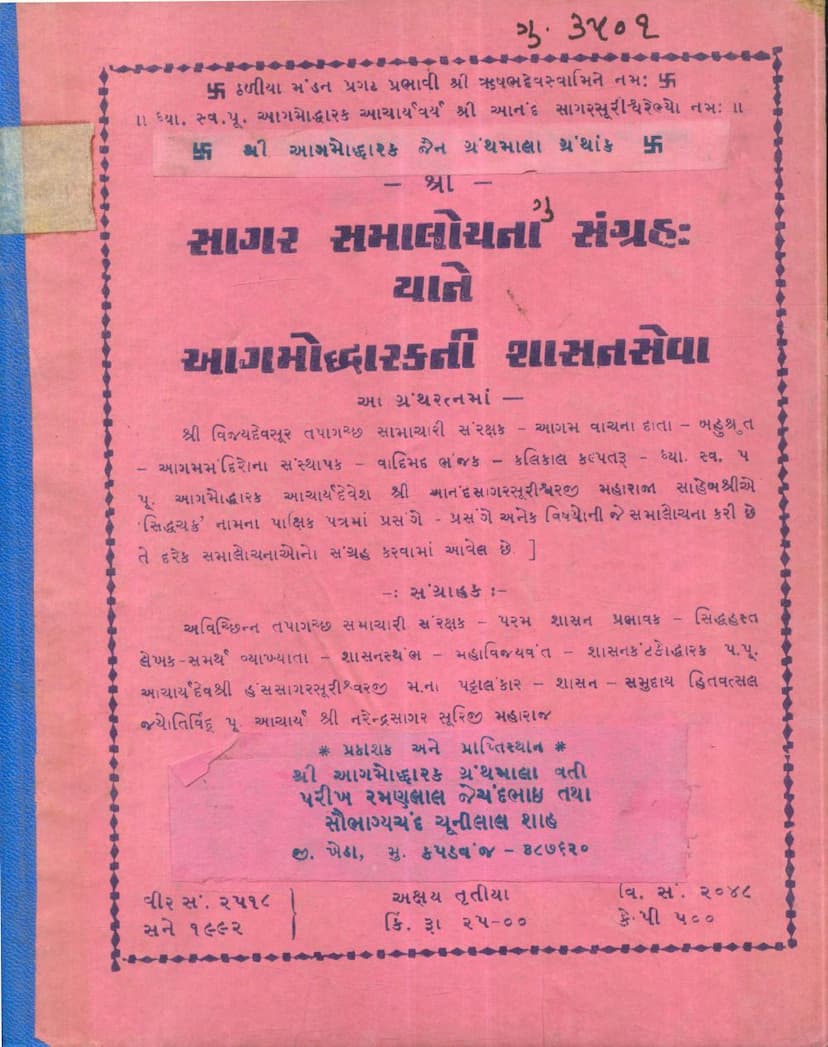Sagar Samalochna Yane Agamoddharakni Shasan Seva
Added to library: September 2, 2025

Summary
This is a comprehensive summary of the Jain text "Sagar Samalochna Yani Agamoddharakni Shasan Seva" by Narendrasagar, published by Agamoddharak Granthmala.
Book Title: Sagar Samalochna Yani Agamoddharakni Shasan Seva Author: Narendrasagar Publisher: Agamoddharak Granthmala
Overall Summary:
The book is a collection of critiques and commentaries ("Samalochna") compiled by Acharya Narendra Sagar Suriji. These critiques were originally published in the fortnightly periodical 'Siddhachakra' between Vikram Samvat 1988 and 2012 (1931-1955 AD). The primary purpose of this collection is to compile and present the insightful analyses and discussions undertaken by the revered Acharya Anand Sagar Surishwarji Maharaj (also referred to as Agamoddharak).
Acharya Anand Sagar Surishwarji Maharaj was a highly respected and influential Jain scholar and spiritual leader. He was known for his deep knowledge of Jain scriptures, his ability to engage in philosophical debates, and his dedication to protecting and promoting the Jain faith and its traditions. The book highlights his significant contributions to the Jain community through his detailed critiques on various topics discussed in the 'Siddhachakra' magazine.
Key Aspects and Content:
- Compilation of Critiques: The book is essentially an anthology of Acharya Anand Sagar Surishwarji's analytical writings that appeared in 'Siddhachakra'. These critiques covered a wide range of subjects concerning Jain philosophy, practices, traditions, and scriptural interpretations.
- Focus on Shasan Seva (Service to the Jain Faith): The title itself signifies that the work is dedicated to serving the Jain faith. The critiques by Acharya Anand Sagar Surishwarji were instrumental in clarifying theological points, defending Jain principles against criticisms, and providing guidance to the community on various matters.
- Author's Role (Narendrasagar Suriji): Acharya Narendra Sagar Suriji, the compiler, is recognized as a protector of the Tapagachchha traditions, a scholar of Agamas, a founder of Agam Mandirs, a master debater, and a propagator of Jain teachings. His role was to gather and present the valuable insights of his predecessor.
- Content of the Critiques: The book contains extensive discussions on a multitude of topics, often in response to questions or debates circulating at the time. These include:
- Scriptural Interpretation: Debates on the authenticity and interpretation of various Jain texts, verses, and concepts.
- Rituals and Practices: Discussions on various Jain rituals, their validity, and their proper observance (e.g., regarding initiation ceremonies, dietary practices, the use of the muhapatti).
- Doctrinal Disputes: Addressing differences of opinion and potential controversies within the Jain community concerning various philosophical points, interpretations of karma, the nature of liberation, and the conduct of monks and nuns.
- Social and Ethical Issues: Critiques and guidance on issues related to societal norms, the role of lay followers, and ethical conduct within the religious framework.
- Historical and Traditional Matters: Addressing questions related to historical accounts, traditions, and the lineage of spiritual leaders.
- Sectarian Differences: The text implicitly or explicitly addresses various points of contention or discussion that arose between different sects or interpretations within Jainism.
- Format and Structure: The "Sagar Samalochna" is structured as a collection of responses to various questions and discussions. The format often involves a question or an assertion followed by Acharya Anand Sagar Surishwarji's detailed and scripturally-backed answer. The extensive nature of the critiques is evident from the numerous numbered points and detailed explanations provided for each topic.
- Purpose of Compilation: The compilation was undertaken with the intention of preserving these valuable critiques for future generations. The understanding was that these analyses would serve as a guide and a protective "Chandrahas sword" against future challenges to Jain principles and practices.
- Acknowledgement of Support: The publication acknowledges the support of various individuals and organizations, indicating a community effort in bringing this work to fruition.
- Emphasis on Correct Interpretation: A recurring theme is the emphasis on understanding Jain principles and scriptures in their correct context, often correcting what the author or Acharya Anand Sagar Surishwarji perceived as misinterpretations or deviations from established teachings.
Significance:
The book is a significant resource for understanding the intellectual and theological landscape of Jainism during the period it was published. It showcases the erudition and commitment of Acharya Anand Sagar Surishwarji Maharaj in safeguarding and elucidating Jain teachings. The collection provides a valuable window into the contemporary debates and concerns within the Jain community and the scholarly responses provided by a prominent Acharya. It also serves as a testament to the detailed textual analysis and argumentative style prevalent in Jain scholarly traditions. The sheer volume of detailed critiques suggests a deep engagement with the nuances of Jain philosophy and practice.